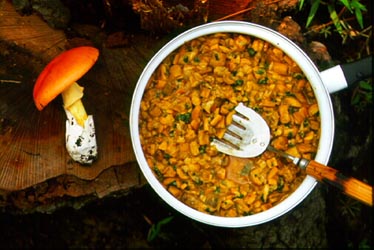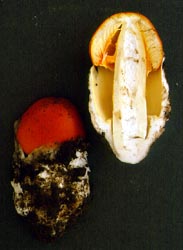|
[ Section Caesareae page. ]
[ Amanita Studies ]
[ Keys & Checklist/Picturebooks ] =Amanita caesarea sensu auct. mexic. (in part) "Bas' Caesar"
Technical description (t.b.d.) BRIEF DESCRIPTION: The following is based on field descriptions by RET. The cap of Amanita basii is 67 - 152 mm wide, brown reddish to "cadmium orange" becoming very intense red, "lake red" or brownish red in the center, somewhat faded by the sun, red-orange in spots, orange-yellow to deep orange at the margin, yellow at the margin in maturity, convex to hemispherical when young, then plano-convex, not umbonate, subshiny where faded, submatte elsewhere, with a nonappendiculate and striate margin (10 - 12% of the radius). The volva is absent in maturity or present as small white patches when young. The flesh is butter yellow to yellowish under the cap skin, yellow in the center and near the margin, pale yellowish white to white elsewhere, 9 - 13 mm thick above the stem, and thinning evenly to the margin. The gills are free, subcrowded, thickest close to the margin, 9 - 12 mm broad, intense yellow to orange yellow to light yellow in mass, primrose yellow to light yellow in side view, with a decurrent line on the upper surface of the stem. The short gills are truncate to subtruncate to rounded truncate, unevenly distributed, of diverse lengths, and scattered. The stem is 124 - 137 × 16 - 23 mm, pale yellow to orange in the upper part of the stem with light yellow as the ground color, becoming brown to blackish with handling, stuffed, subcylindric to cylindrical, with fibrillose-floccose or irregular ragged patches and strands of orange-yellow felted to membranous material on the outer surface; the stem decoration becomes more intensely orange when handled. The ring is attached in the upper part, subapical, skirt-like, copious, membranous, persistent, orange-yellow at first, becoming yellow-orange. The saccate volva is smooth, white, with yellow tints on the inner surface, dry, membranous, firmly attached to the stem. The flesh is white, staining light yellow, fibrillose, and stuffed with moderately dense material. The odor is pleasantly fungoid. The taste is sweetish. The spores measure (8.0-) 9.0 - 11.8 (-18.0) × (5.5-) 6.1 - 7.5 (-9.0) µm and are broadly ellipsoid to ellipsoid to elongate (rarely cylindric) and inamyloid. Clamps are common at bases of basidia. Amanita basii occurs in forests of pine (Pinus), oak (Quercus), fir (Abies), and alder (Alnus) in Mexico. The felted material on the stem is originally the continuation of the limbus internus. In early development, the limbus internus can be seen as a small, white wedge of volval material attached to the volval limb several millimeters above the point of attachment of the volva to the stem. The species is strikingly similar to a sister species, Amanita caesarea (Scop. : Fr.) Pers., of the Mediterranean region. RET thinks that it is highly unlikely that A. basii occurs in Spain and that A. caesarea occurs in Mexico as was stated in the original description of A. basii. The recipe displayed in the image on the left, was prepared in a field kitchen from A. basii, a mixture of boletes, and diverse local herbs at Nanchititla State Park in the State of Mexico, Mexico. -- R. E. Tulloss and L. Possiel Photos: Ricardo García Sandoval (left, in skillet with boletes); R. E. Tulloss (right)
[ Section Caesareae page. ]
[ Amanita Studies ]
[ Keys & Checklist/Picturebooks ] Last changed 29 September 2009. |

